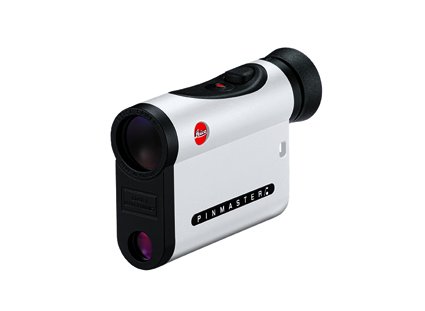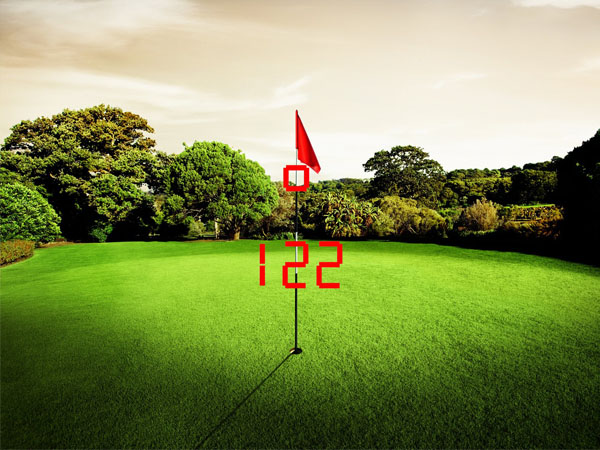The Leica Pinmaster II. The supermodel of laser rangefinders. Slim and light, an exceptional form factor. Extremely expensive. You can impress your friends with it.
The Pinmaster II is one of the smallest and lightest laser rangefinders tested, sporting a carbon-reinforced body that is not only waterproof, but get this – submersible! The Pinmaster II offers an industry best 7x magnification (matching the < a href="https://www.criticalgolf.com/reviews/laser-rangefinders/bushnell-pro-1m-laser-rangefinder-review/">Bushnell Pro 1M series), with a collapsible eyepiece for glasses wearers. The LED display allows users to easily see distance readings in any light condition and with no artificial tints. The Leica Pinmaster II features just one crosshair option (a small square), and allows users to pan across targets and received distance readings that update at a consistent speed.
Sounds like a great set of features, doesn’t it? We were excited to have saved up enough money (and given the price tag, this took a while) to purchase the Pinmaster II and get it to the course for a full review. Our first device, however produced so many errors in readings that we sent it back to the retailer for an exchange. Our second Pinmaster II fared better, but still on occasion would inexplicably return distances shorter than the actual distance, and we constantly struggled to lock on to a target. Aside from those problems, we would also prefer both a slightly larger crosshair and larger font for the distance display.
So as we were saying, the Leica Pinmaster II is the supermodel of laser rangefinders. But like a supermodel, it’s blisteringly expensive to acquire, and once you get past the surface, you’ll find it has issues that you really don’t want to deal with on an ongoing basis.
Pros:
- Great form factor and looks
- Smallest device with 7x magnification
- Crisp clear display with natural colors
Cons:
- Incredibly high price
- Occasionally returns readings shorter than actual distance
- Frustrating to try to acquire targets
Retail price: $499 (new retail price, down from a blistering $699)
Amazon.com: Check price now
EASE OF USE
The Pinmaster II is one of the smallest and lightest rangefinders tested. Vertically oriented, with a smooth but not slippery surface, the device is easy to hold. The included carrying case doesn’t add much to the overall weight, and has a slot through which a belt or bag strap can be threaded (which is already starting to detach after relatively little use) and a clip to close the case. We much prefer carrying cases that use clips to allow you to quickly attach the carrying case to your bag or push cart. While the device is actually small enough to keep in a pocket during play, it’s still a bit too bulky for that to be convenient.
The 7x magnification of the Leica Pinmaster II is the highest level of magnification offered by golf laser rangefinders, matching the < a href="https://www.criticalgolf.com/reviews/laser-rangefinders/bushnell-pro-1m-laser-rangefinder-review/">Bushnell Pro 1M, and in a much smaller form factor, weighing only 7.3 ounces and measuring 4.5″ x 2.25″ x 1.25″. The user can easily focus the display by twisting the eyecup, which can be compensated up to +/- 3.5 diopters.
Like most laser rangefinders, the Pinmaster II features two buttons to control the device. There is a raised button on the top of the device near the eyecup used to power on the device as well as fire the laser, and a secondary button just forward of it that is used to toggle units between yards and meters. The battery compartment is located just below the eyecup on the front of the unit.
To obtain a distance reading, the user needs to tap the firing button once to display the square LED crosshair, pause a moment, and then tap again to get a distance reading – though sometimes it took us multiple attempts to be able to start obtaining distances. After the initial tap of the fire button, if you hold down the firing button the second time you press, after a split-second, the targeting square and distance readings will appear and provide continuously updated distance readings, blinking as the player pans across targets.
While the LED display makes the small square crosshair easy to see against all backgrounds, we would prefer a crosshair that is larger with thicker lines, and/or the option of a different crosshair style. The viewfinder provides a clear view with accurate color, as one would expect from Leica – the optics don’t provide an artificially darker view or tint, noticeable on some other laser rangefinders.
The Leica Pinmaster II takes one 3 volt CR-2 Lithium battery, good for up to approximately 2,000 measurements. There is no battery meter that is displayed – when the battery gets low, the distance display and crosshair will start to blink, at which time the device should have about one hundred measurements remaining (that number will be smaller if you use the panning function).
For more details, check out the Critical Golf comparison of laser rangefinder ease of use.
FEATURES
The Leica claims to have “first target logic”, which in theory should allow the device to just show the distance to the closest target when there are multiple objects in the crosshairs, such as a flagstick against a background of trees behind the green (ostensibly similar to the Bushnell’s “Pinseeker” and Leupold “Pinhunter” technologies). In reality we found Leica’s technology to be disappointing – see ‘Obtaining Distance Readings’ below.
Features that are a plus for the device include the red LED and exceptional Leica optics, with a coating that helps shed dirt and water from the lens (we haven’t had any issues). The one negative to the optics is the faint image of a computer chip as well as some small red lines that you can sometimes see by the targeting square, depending on the background and lighting, almost as if you are seeing the “guts” of the laser components.
The Pinmaster II is waterproof, though only to 3 feet, so if you toss it into the pond in a fit of range, you are going to have a very short amount of time to retrieve it as it sinks. Both yards and meters are available, which can easily be toggled by use of the secondary button on the top of the device.
For more details, check out the Critical Golf comparison of laser rangefinder features.
OBTAINING DISTANCE READINGS
The Leica Pinmaster II is marketed as providing exact distance readings up to 820 yards, which is quite a bit further than our drives, even if we’re going downhill. With a really really stiff breeze at our backs.
Distance readings will continue to be displayed on the LED display for approximately 8 seconds after the firing button is released. The Pinmaster II will allow users to continue to fire the laser for over a minute without shutting down (if you need to fire for longer than that, perhaps you should consider a golf GPS device instead!).
Inexplicably, on occasion the Leica Pinmaster II will return a distance reading shorter than the actual distance. Talk about “first target logic”! Kidding aside, this is a pretty disturbing glitch in the device. We experienced this in situations such as targeting flagsticks from a short distance (<100 yards) and tree trunks at longer distances (~145 yards). before anyone gets the idea that we might have had a defective device, should mention device reviewed was actually our second Pinmaster II – the first device quite regularly provided distances readings shorter than actual distances, and had enough problems targeting simple targets that we returned the unit. That the second device we received still has issues doesn’t bode well at all.
The device in particular would struggle with targets that have background objects relatively close, such as in the situation where targeting a flagstick with green edge or mounding behind. In cases where an object was only 15-20 yards behind the flagstick, for example, quite often it will lock on the object in the back. We did find that when we adjusted the line of sight to aim higher on the flagstick, and create a wider gap to the object behind (say 50+ yards), it was much easier to lock on the flagstick.
At shorter distances to flagsticks or tree trunks, we found when the flagstick or other targets took up half of the target square, the device would still frequently lock onto targets in the background – as far as we’re concerned, the “first target logic” needs to have higher sensitivity. As with all devices, the Leica Pinmaster II was better able to lock on to the flag, as opposed to the flagstick. Even when the square crosshair surrounds the flagstick, the Pinmaster II will struggle, unlike other laser rangefinders that will give some leeway and lock on even if the entire cursor does not surround the flagstick.
Ease of Locking on a Flagstick:
When targeting the flagstick at a distance (focusing on the flag, not just the pin), the Leica performed well at a range of distances.
- The Pinmaster II can target flags with relative ease from the shortest distances up to 200 yards. The Pinmaster II seems to have more difficulty in targeting flagsticks than other devices, but at most any distance we recommend targeting the flag, or the ground at the hole, for the quickest and most accurate reading.
- From 200 to 300 yards, the Pinmaster II remains consistent in returning distances throughout at roughly 80-90%% of the time, we believe assisted by the 7x magnification. At beyond 300 yards the magnification continues to assist, though becomes more difficult and drops below 80%.
Speed Test:
The Pinmaster II only has one mode available – scan. The Pinmaster II updates distance readings while panning at the same speed regardless of distance (nice and steady in 1/2 second increments), though it takes a shade longer than other devices in providing the initial distance reading.
- Scanning Mode: When we compared the Leica Pinmaster II in its one mode against other devices in their “scanning” modes, we found it to be one of the slowest in our tests.
- Pin-Locating Mode: Compared in its one mode against other devices in their “pin-locating” modes, it finished in the middle of the group. This is expected, as a device in panning mode will be able to pick up multiple targets more rapidly than one in pin-locating mode.
- Using Both Modes: The Pinmaster II finished as one of the faster devices compared to the group that allows the user to switch between panning and pin-locating modes, not surprising given that the Pinmaster II doesn’t require switching modes.
For more details, check out the Critical Golf comparison for ease of obtaining distance readings.
COST/VALUE
Note: Leica in 2017 took the retail price for the Pinmaster II down to a much more sane $499)
At a brutal $699 retail, the Leica Pinmaster II runs away as the most expensive laser rangefinder on the market. This won’t surprise those that already own other Leica products (notably their cameras) – you pay for the quality optics you get. The high price tag alone likely explains why we have never seen another unit in person besides the one we purchased (and this price is actually $100 less than the original Leica Pinmaster!).
We don’t give the Pinmaster II a low Cost/Value rating just for its price, however. The inability to quickly lock on to flagsticks and problems with erroneous readings lead to a poor user experience that its form factor and crisp optics simply can’t make up for.


